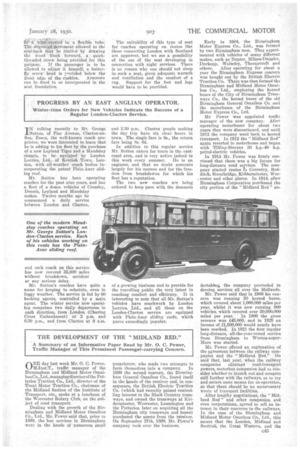PROGRESS BY AN EAST ANGLIAN OPERATOR.
Page 67

Page 68

If you've noticed an error in this article please click here to report it so we can fix it.
Winter-time Orders for New Vehicles Indicate the Success of a Regular London-Clacton Service.
IN talking recently to Mr. George
Sutton, of Pier Avenue, Clacton-onSear Essex, the well-known coach proprietor, we were interested to learn that be is adding to his fleet by the purchase of a new Leyland Tiger and a Maudslay chassis, to be equipped by London Lorries, Ltd., of Kentish Town, London, with all-weather coach bodies incorporating the patent Plein-Azur eliding roof.
and each coach on this service has now covered 35,000 miles without breakdown, accident or any serious delay.
Mr. Sutton's coaches have quite a name for keeping to schedule, _even in foggy weather. The service is fed by 60 booking agents, controlled by a main agent. The winter service now operating comprises two daily departures in each direction, from London (Charing Cross Embankment) at 2 p.m. and 6.30 p.m., and from Clacton at 9 aim
and 2.30 p.m. Clacton people making the day trip have six clear hours in town. The single fare is Gs., the return fare being Ss. eel.
In addition to this regular service Mr. Sutton eaters for tours in the eastcoast area, and is very active indeed in this work every summer. Ile is an engineer, and that no doubt accounts largely for his success and for the freedom from breakdowns for which his fleet has a reputation.
The two new coaches are being ordered to keep pace with the demands of a growing business and to provide for the travelling public the very latest in coaching comfort and efficiency. It is interesting to note that all Mr. Sutton's vehicles have coachwork by London Lorries, Ltd., mad all those on the London-Clacton service are equipped with Plein-Azur sliding roofs, which prove exceedingly popular.
Early, in 1904, the Birmingham Motor Express Co., Ltd., was formed by two Birmingham men. They experimented with vehicles of many different makes, such as' Napier, Milnes-Daimler, Durkopp, Wolseley, Thornycroft And
others. After operating for about a year the Birmingham Express concern was bought out by the British Electric Traction Co.. There was then formed the Birmingham and Midland Motor Omnibus Co., Ltd., employing the horsed buses of the City of Birmingham Tram. ways Co., the horsed buses of the old Birmingham General Omnibus Co. and the motorbuses of the Birmingham Motor Express Co., Ltd.
Mr Power was Appointed traffic manager of the new company. After operating motorbuses for about two years they were discontinued, and until 1912 the company went back to horsed transport. In 3912 the 'Midland Red" again reverted to motorbuses and began with Tilling-Stevens 30 h.p.-40 h.p. petrol-electric vehicles.
In 1914 Mr. Power was firmly convinced that there was a big future for long-distance road services. The company started routes to Coventry, Redditch, Stourbridge, Kidderminster, Wor; eester and other places. In 1914, after Birmingham Corporation purchased the city portion of the "Midland Red" an dertakinge the company proceeded to develop services all over the Midlands.
Mr. Power said that in 1900 his concern was running 50 horsed buses, which covered about 1,000,000 miles per year, whilst it was now running 800 vehicles, which covered over 00,000,000 miles per year. In 1900 the gross revenue was £45,000, and in 1929 an income of 4,500,000 would nearly have been reached. In 1921 the first regular long-distance, all-the-year-round service from Birmingham to Weston-superMare was started.
31r. Power offered an explanation of the agreement between the railway companies and the "Midland Red." He said that, last year, when the railway companies obtained road-transport powers, motorbus companies had to cansider whether to launch out and compete still further with the railways, or to try and secure some means for co-operation, so that there Should be no unnecessary waste of transport facilities.
After lengthy negotiations, the "Midland Red" and other companies, and even corporations,, agreed to sell an interest in their concerns to the railways. In the case of the Birmingham and Midland Motor Omnibus Co., Ltd., this meant that the London, Midland and Scottish, the Great Western, and the
London North Eastern Railway Companies now owned half the shares, and each would be represented on the board of directors and local advisory committee. It was not a question of control, but simply of co-ordination of interests.
Mr. Power then discussed the Road Traffic Bill and said that he was strongly in favour of the age of a driver in control of a vehicle exceeding 21 tons being raised from 17 years to 21 years. He strongly agreed with the recommendation that all mechanically propelled vehicles should be equipped with the dip and swivel headlights, and he considered that all manufacturers should be compelled to supply them as component parts of their vehicles. He thought that the number of licensing authorities should be reduced from over 1,100 to about 300.
As to the public inquiry into fatal accidents, Mr. Power suggested that if coroners' inquests were attended by an official of the Ministry of Transport that would be sufficient. He was in favour of compulsory insurance. He also agreed with the recommendation that every vehicle used for the conveymice of passengers must have a certificate of fitness, issued by a duly authorized and qualified expert, stating that the vehicle complied with the constructional requirements prescribed by the Minister of Transport, with regard to both chassis and body.












































































































